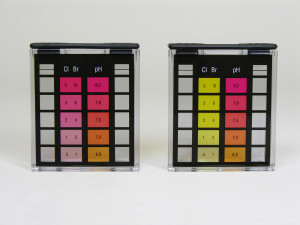Myth 4: Unlike liquid tests, test strips are so easy to use there is no such thing as proper technique
Granted, test strips are as simple a testing device as you are going to get, but they are not foolproof. Therefore, the following precautions must be taken:
- Limit the test strips’ exposure to air;
- Keep them dry before use;
- Do not contaminate the pads by touching them or setting them down on a dirty surface;
- Immerse as instructed. Dipping, swirling and swishing are different motions designed to expose the reagent pads to the water in a precise way for a specific time;
- Read instructions carefully, as some will say after wetting the pads to shake off the excess water, while others may warn against this;
- Let the correct amount of time elapse for starting and completing the readings;
- Read test values in the order given (those at the end of the sequence require the longest reaction time);
- Prevent reagents from running between pads by holding the test strip horizontal to the ground when comparing colours;
- Make colour matches in natural light, without sunglasses; and
- Do not use test strips past their expiration date.
Myth 5: Water samples can be taken from any convenient location in the pool
For your test results to be actionable, it is important to take a sample of water that is representative of the entire pool. Samples should not be taken from the water’s surface where it is interacting with the atmosphere, and possibly carrying debris and oils. Further, refrain from taking water samples from the immediate vicinity of a return line or chemical feeder, or in a dead zone (e.g. next to stairs) as these areas are also subject to special conditions.
When a pool has both shallow and deep ends, the sample should be taken midway between them using a clean plastic bottle. The bottle should be inserted into the water bottom-side up so the trapped air keeps out the water momentarily, then once at elbow depth, turn it right-side up and let it fill. If you just added a treatment chemical, allow at least two filtration cycles to pass to allow the chemical to circulate throughout the pool/spa before retesting the water.
Myth 6: Testing indoor/outdoor pools/spas is all the same
Ambient light is an important consideration in testing. Most manufacturers recommend performing colour-matching tests in natural light (but not looking into the sun). This is because artificial lighting will skew your colour perception—same with wearing sunglasses.
If finding natural light is inconvenient when testing indoors, buy an inexpensive illuminator like photographers use to simulate daylight and perform colour comparisons in front of it. If you are using a colourimeter, keep in mind, stray light may interfere with tests, so be sure to cap the sample chamber if so directed.
Myth 7: Orthotolidine (OT) solutions are more reliable than N, N-diethyl-p-phenylenediamine (DPD) reagents for testing chlorine

This myth likely started because OT solutions have a longer shelf life than liquid DPD reagents. If the pool/spa is sanitized with bromine, an OT test is fine to use; however, OT is not the best choice if the water is sanitized with any form of chlorine. This is because chlorine users must keep track of how much chemical is in its strongest germ-killing form and how much of it is past its prime. The most effective form of chlorine is referred to as free chlorine. When free chlorine has done its job eliminating ammonia and nitrogen compounds introduced to the water by bathers, chloramines (combined chlorine) are formed. Besides being a weaker, slower-acting disinfectant than free chlorine, chloramines give off a strong, unpleasant odour, which can irritate bathers, even at low levels. Together, free chlorine and combined chlorine make up the total chlorine residual.
DPD tests can distinguish between free and combined forms of chlorine. OT tests can only read total chlorine. Due to this limitation, regulatory codes governing public and semi-public facilities invariably specify operators must be able to determine the free chlorine residual, thus most codes cite DPD specifically for chlorine testing. You should make sure pool/spa owners are aware of this, as well, so they can make an informed decision about their testing supplies.
By the way, a quick way to tell if a test kit employs the DPD method is to look at the colour standards in the test block. If they are shades of pink, it is a DPD test; shades of yellow indicate an OT test.






